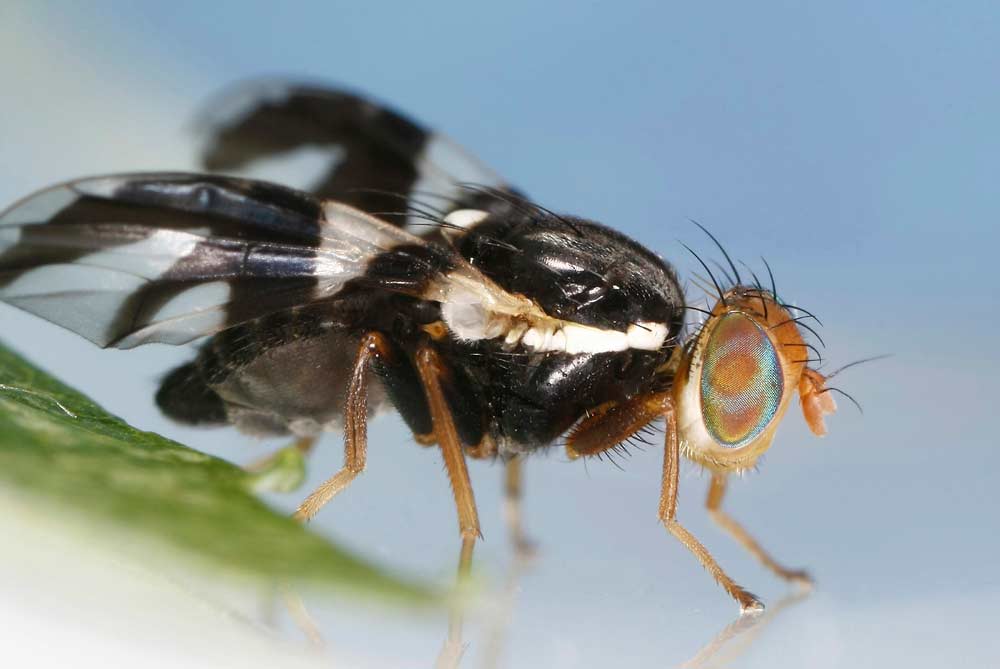
An apple maggot fly (Rhagoletis pomonella). Most of Washington’s apples are grown in a quarantined area free of the pest. (Courtesy Joseph Berger)
Today, the vast majority of Washington’s apples are grown in regions that remain free of apple maggot infestation.
However, if the pest invades those areas through the movement of green waste from infested urban areas for composting in apple country, it could cost the industry up to $550 million a year.
That’s according to a recent analysis by Washington State University economist Karina Gallardo.
“If we lost 100 percent of the apple maggot-free area, it would represent $510 million to $550 million a year,” Gallardo said in a presentation to the Washington Tree Fruit Research Commission, which funded her study.
After a 2016 pest risk analysis found that moving municipal green waste from infested urban areas to composting facilities in pest-free zones posed an unacceptably high risk of spreading it, the state began requiring a permit proving the material has been treated sufficiently to kill apple maggots before transfer.
The costs of apple maggot infestation occur both in the orchard and at export, and Gallardo took both into account to estimate the total value of protecting the current apple maggot-free areas.
In the orchard, the cost of controlling apple maggots depends on how much growers are already spraying for codling moth, since the same pesticides control both. Variety matters, too, since earlier harvesting apples like Gala require fewer sprays than late-season apples, such as Fuji.
Based on the advice of entomologists, Gallardo estimated that conventional orchards with moderate codling moth pressure would have to spend between $87 to $225 an acre to control apple maggot, depending on harvest timing. Growers with low codling moth pressure would have to spend $257 to $396 more per acre. Organic growers would need two additional sprays of Entrust at a cost of about $111 per acre.
“If the pressure of codling moth is high, there will only be one additional spray by the end of September required to control apple maggot,” Gallardo said. “So, the costs are divided into these scenarios; we can’t get more precise unless we map codling moth pressure across Washington.”
On the export front, the apple maggot quarantine matters for two markets: China and Canada. Specifically, Canada restricts apples exported to British Columbia, but since a significant portion of Washington’s Canadian apple exports are shipped to Eastern Canada via B.C., Gallardo chose to use the export figures to B.C., Alberta and China in this analysis to conclude that the quarantine would impact 1.74 percent of Washington’s exports.
Exports to Mexico are already covered by requirements to control the oriental fruit moth, which would also control apple maggots, so nothing there would change, Gallardo added.
The apple maggot quarantine restriction requires 40 days of storage at 1 degree Celsius, which adds a cost of $11 per bin.
That additional time in storage means greater competition from other imports, and shipping delays could depress prices slightly; Gallardo estimates about a 1.8 percent price decline for Red Delicious and Gala and 3.1 percent decline for Fuji.
Currently, less than 1 percent of Washington’s commercial apple acreage is in areas both threatened by apple maggot activity and quarantined, thereby incurring both the costs of pest control and export restrictions.
About 14 percent of conventional acreage is under quarantine, but not actively threatened by the pest. And 85 percent of the conventional acreage and 97 percent of organic acreage is located in areas that remain both pest- and quarantine-free.
Through assessments, growers fund the Washington State Department of Agriculture’s apple maggot control program for about $750,000 a year, for trapping surveys, support to county pest boards for control and education efforts. It has a great cost to benefit ratio, Gallardo said.
“A 20 percent loss in apple maggot free areas would represent 100 to 110 million dollars (according to) the results for the three scenarios of codling moth pressure, compared to the $700,000 per year preventative program cost,” she said in an email. •
—by Kate Prengaman






Leave A Comment